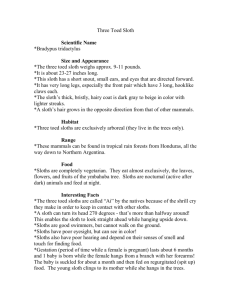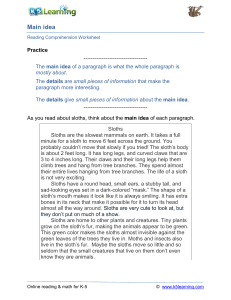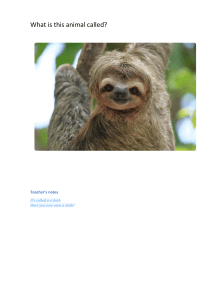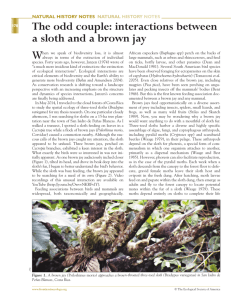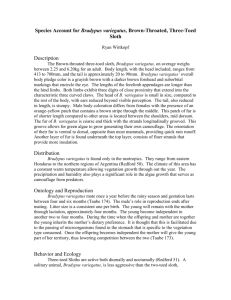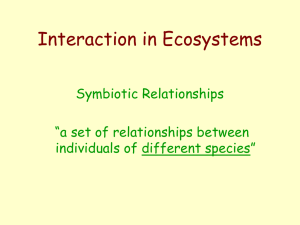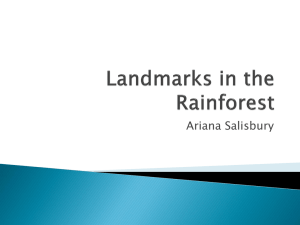Brown-throated Three-toed Sloth
advertisement
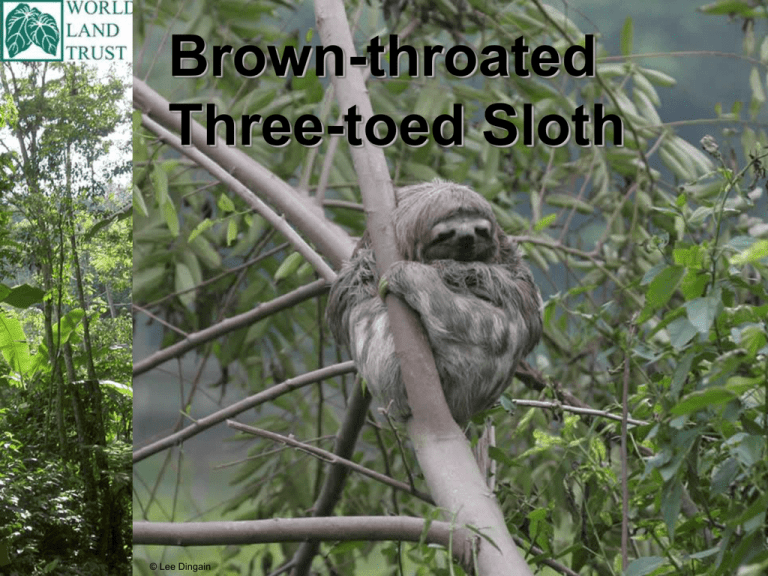
Brown-throated Three-toed Sloth © Lee Dingain Brown-throated Three-toed Sloth Scientific name is Bradypus variegatus The Brown-throated Three-toed sloth can be found throughout southern Central America into much of South America. Click here to find outBolivia, which countries this sloth is Costa found inRica, In these countries: Brazil, Colombia, Ecuador, Honduras, Nicaragua, Panama, Paraguay, Peru, Venezuela. What habitat do they live in? What habitat do you think they live in? Click here to find out. Brown-throated Three-toed Sloths live in tropical forests. © Kirsty Burgess/WLT They are very fond of these types of trees. Why are they threatened? All tropical forest living mammals are vulnerable to habitat destruction. Here a large area of rainforest has been cleared so that a holiday home can be built © Kelly Jacobs/WLT One theguess placesthe this animal lives is calledin the Canofyou name of the rainforest Atlantic Rainforest. This is further south than the Brazil where the Brown-throated Three-toed Sloth Amazon in Brazil into Paraguay and lives? Click here toand find stretches out Argentina, this habitat is very endangered. Natural hunters of the sloth 1) Harpy Eagles can pluck sloths Click here to see a picture of right out of the tree a Harpy Eagle © Kirsty Burgess/WLT 2) Jaguars can catch sloths when they come down to the ground Click here to see a picture of a Jaguar © Silvia Centron How do they communicate? © Alan Martin Sloths live alone (they are solitary) and do not need to communicate with other sloths very often. • Baby if they are having difficulty climbing Can yousloths guessmay whathiss noises a sloth might use to communicate? • Females may Click here to findmake out a high pitched cry to attract a mate • Male sloths may make noises if they fight What do they eat? © Alan Martin Brown-throated Three-toed Sloths are herbivores. What think this means that they eat in Theydo eatyou tree leaves, flowers, shoots the Click here to find out andrainforest? some fruit. How long do they live? Brown-throated Threetoed Sloths live about 20 years or more in the wild. Brown-throated Three-toed Sloths are about the size of a cat, 40 – 80 cm long. © Lee Dingain How big are they? What do they look like? The three long curved claws on the front feet of Brown-throated Three-toed sloths are very strong and support them hanging upside down, or sitting, high up in trees. They look as though they are always smiling. They have longer arms than legs. They have short stubby tails. © Lee Dingain They have long, coarse grey-brown hair. Tell me about their babies: Brown-throated Three-toed Sloths give birth to one baby a year. © Alan Martin The baby will be carried about on its mother’s stomach for about 6 or 9 months. Interesting facts: • A simple plant called Algae, grows on the fur of the Brown-throated Threetoed Sloth. This can make the sloth look green, and camouflages it among the leaves of a tree. © Lee Dingain • Sloths will move in to a patch of sunlight to warm up, and move out of sunlight to cool down. A story from the wild: One of the conservation organisations working to save the Atlantic rainforest in Brazil is called REGUA. The Director of REGUA is called Nicholas. Because cannot walk they drag Why dosloths you think the sloth was in themselves along very slowly and this danger here? Click to find out sloth was in danger of getting run over. © Alan Martin One day Nicholas left the forest to go into the town. When he was in the town he saw a Brown-throated Three-toed Sloth on the road. This is a picture of the sloth being released from a sack next to a tree. The sloth climbed the tree andtoby theanext dayofit what had Click here see picture disappeared into the forest. happened next © Alan Martin Nicholas rescued the sloth and took What do you think Nicholas did?it to the forest reserve where heClick works. here to find out © Alan Martin If you choose the Brown-throated Three-toed Sloth as your fundraising focus, your donation will go towards World Land Trust projects for the conservation of wildlife habitat in the Atlantic rainforest of Brazil.

